This was published 9 months ago
From tobacco factory to artistry, this suburb is the southside’s northside
Creatives, breweries, patisseries and young families are springing up in the suburb’s once-gritty industrial precinct, which used to be home to soft drink manufacturers and big tobacco companies.
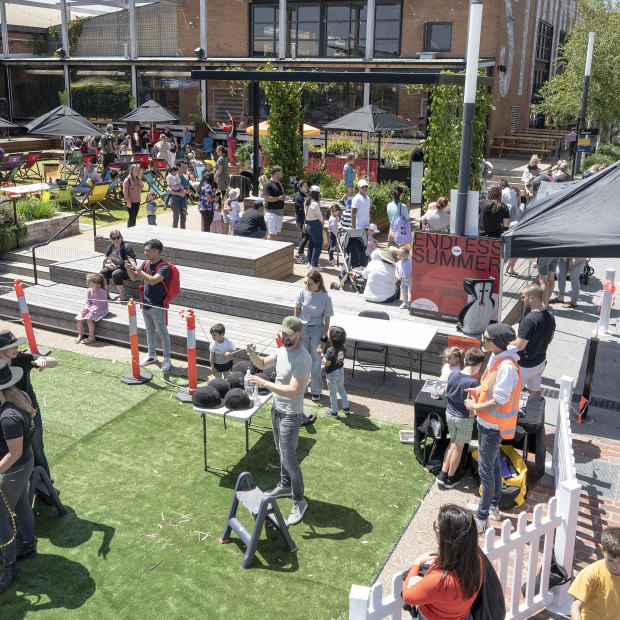
Morris Moor in Moorabbin.
Almost all the memories Adele Locke has of Moorabbin from her childhood in the 1990s involve scent.
Most raw: stepping out of her father’s factory in the industrial pocket of the suburb and inhaling the sweet, honey-like aroma of tobacco leaves being roasted by tobacco giant Philip Morris, just down the road.
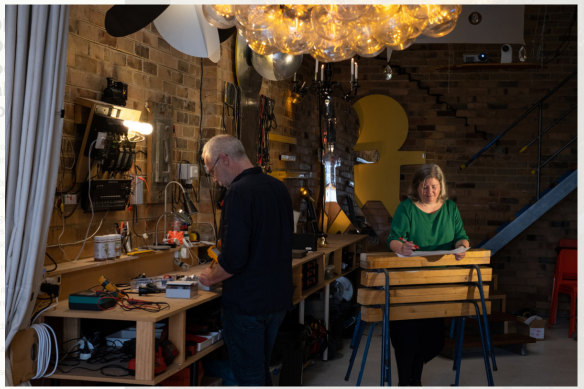
Adele Locke (right) grew up in her father’s Moorabbin lighting factory, and now makes her own lights in the area.Credit: Penny Stephens
“It sounds strange, but it was one of the most beautiful smells I have ever smelt in my life,” Locke recalls.
Other odours were not so pleasant. Like the gritty scent of smoke, dirt and sweat that overwhelmed her when she and her dad visited the Moorabbin electroplating factory, where fire pits roared in the ground.
“As a little kid I thought I was walking straight into hell,” she says.
“It was so hot in there. It was a dramatic place. But that was manufacturing in Moorabbin back in those days. The factories were full of people working hard.”
After growing up in the four walls of her dad’s factory, which specialised in light fittings for tennis courts, Locke serendipitously found herself drawn back to Moorabbin’s industrial hub 11 years ago, lured by affordable rent.
She opened her own architectural lighting design business, Mint Lighting Design, around the corner from her dad’s old factory.
“It was like a desert here when we moved in,” Locke says. “There was not a lot around, we couldn’t even get coffee.”
But soon after, renowned artist and one of the great painters of the Australian landscape, the late Philip Hunter, and his partner Vera, began renting a space across the road.
Their arrival marked the start of an exodus of artists from factories in Brunswick and Melbourne’s inner suburbs, securing cheaper warehouses in suburbs like Moorabbin.
Last week, the soft, golden glow of lights in the front window of Locke’s factory on a gloomy winter’s day illuminated the changes in Moorabbin’s industrial precinct.
Locke says the area offers artists what Brunswick did 30 years ago: cheap rent and space to create.
Warehouses are no longer full of tobacco and manufacturing factories, mechanics and panel beaters. Instead, behind the roller doors is a little-known world of creatives, entrepreneurs and foodies. They specialise in metal fabrication, mosaics, non-alcoholic wine and pastries.
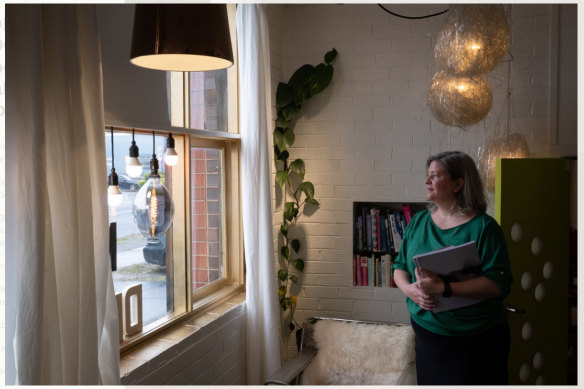
Locke in her factory – she is one of the many creatives reviving the once-gritty Moorabbin manufacturing hub south-east of Melbourne’s CBD.Credit: Penny Stephens
“There’s a lot of really interesting, quirky things that happen here in Moorabbin’s industrial precinct, because there’s a bit more of a nightlife now. There are parties, live bands and crazy stuff going on in streets all the time,” Locke says.
“And because it’s an industrial area, and will always be an industrial area, people get up to nonsense here. That’s quite fun. You can’t get up to this kind of mischief in the suburbs elsewhere.”
About 15 kilometres south-east of the CBD, Moorabbin is known for many quirky things – including a miniature railway. There’s also a graveyard for old planes at Moorabbin Airport, home to one of the most significant collections of historic aircraft in the country. The suburb’s flat ground is ideal for airfields, and about a third of the country’s pilots train at Moorabbin Airport before taking flight.
Much of the eastern side of the suburb has been a thriving industrial area since the mid-1960s, after major companies such as Coca-Cola, Schweppes and Philip Morris set up headquarters there.
RSEA Park, traditionally known as Moorabbin Oval, is also famed for being the much-loved home ground of the St Kilda football club.
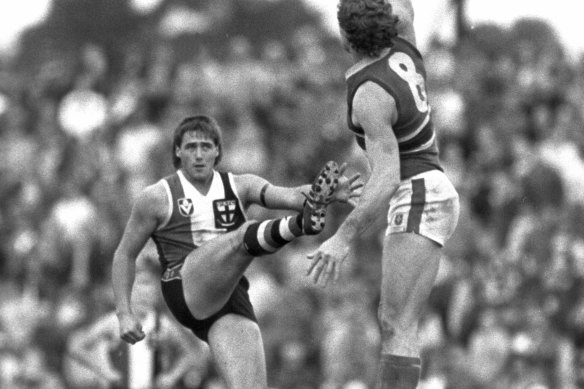
St Kilda’s Tony Lockett kicks his 100th goal of the 1987 VFL season, at Moorabbin.Credit: The Age
When the Moorabbin Town Hall opened in 1963, its modernist design of chunky concrete beams and large timber-framed windows became something of an architectural wonder.
It was even a popular venue for bands in the 1970s and ’80s, and rock legends AC/DC and INXS performed there. This fleeting era was immortalised in a photograph of a 1976 AC/DC concert, capturing a crowd of “sharpies” and “toughs” with their mullets and idiosyncratic fashion – an ode to the subculture of suburban youth gangs that flourished in the late ’60s and early ’70s.
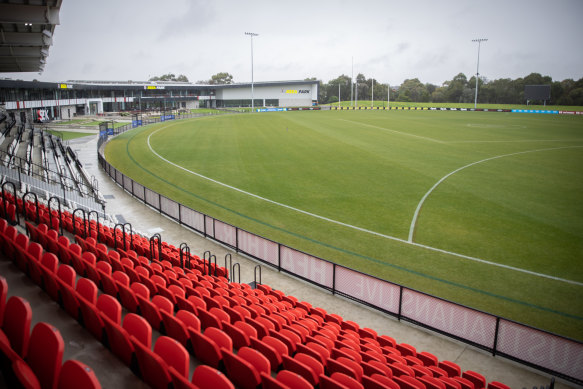
RSEA Park, traditionally known as Moorabbin Oval, is the much-loved home ground of the St Kilda Football Club.Credit: Simon Schluter
But the old Moorabbin is a world away from what is to come for this suburb.
New people and cultures are moving in ahead of a projected population boom, and change will only accelerate from here. The population of the surrounding municipality, the City of Kingston – which also takes in the bayside suburbs of Chelsea and Bonbeach – is forecast to grow from 166,212 to 195,819 by 2041.
The Victorian government has unveiled ambitious new housing targets for Melbourne council areas, proposing 59,000 new homes by 2051 for Kingston – almost doubling the 69,000 homes in the municipality.
While other councils are vehemently pushing back against such a dramatic surge in homes, the goal has been welcomed by the City of Kingston and Mayor Jenna Davey-Burns.
“We have reached a point where the most basic of our needs is at risk because housing supply just doesn’t stack up,” says Davey-Burns. “We have to do something about it and the consultation on housing targets is one step forward.”
Medium- and high-density housing has also been earmarked for activity centres, including along the Nepean Highway, signalling a new era for the Moorabbin, where classic post-war homes, including 1950s clinker-brick houses, have long been emblematic of the streetscape.
Davey-Burns says anyone driving through Moorabbin may be mistaken for thinking there is not a lot going on in the suburb.
“You wouldn’t really understand it, you’d look and think there’s nothing much happening here. It feels a bit transient,” she says. “But the heart of the suburb is killing it.”
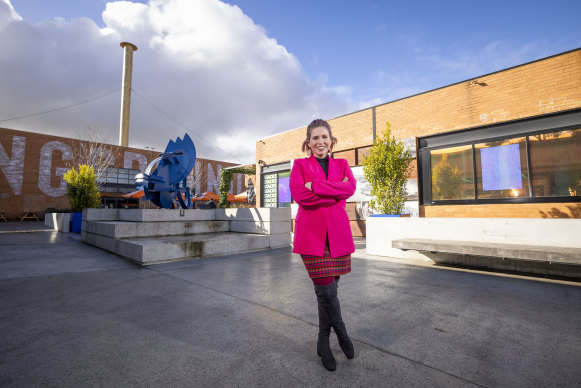
Kingston Mayor Jenna Davey-Burns outside the Morris Moor development.Credit: Wayne Taylor
The multimillion-dollar revamp of the old Philip Morris cigarette factory, part of the six-hectare Morris Moor precinct on Cochranes Road, is now home to a Stomping Ground Brewery and Beer Hall.
Metres away sits the headquarters of Penny for Pound (revered for its croissants, baked up to four times a day), restaurants, a yoga studio, an urban park and office space used by creatives and entrepreneurs.
The influx of younger professionals in the area was reflected in the 2021 census, which found that the average age in Moorabbin was 39. Residents had also catapulted up the wealth scale, with households taking home an average of $2031 a week, compared to the Victorian median of $1759.
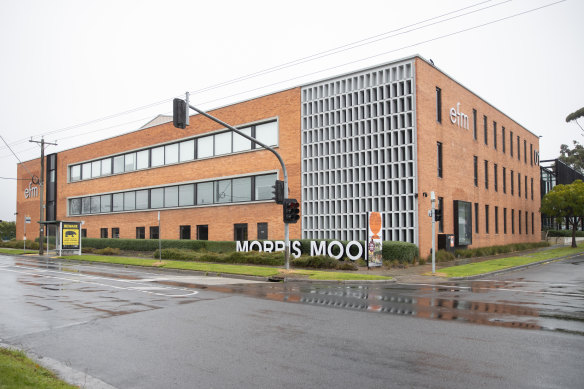
The old Phillip Morris factory.Credit: Simon Schluter
A new wave of migration
Migration waves are shifting too, as the cultural diversity of the suburb swells. About 62 per cent of residents were born in Australia, according to the most recent census data, while about 4 per cent were born in India, 3.4 per cent in China, 3.2 per cent in England and 1.8 per cent in Greece.
From inside her milk bar and bottle shop on Chapel Road, Tammy Zakharia has watched Moorabbin shift.
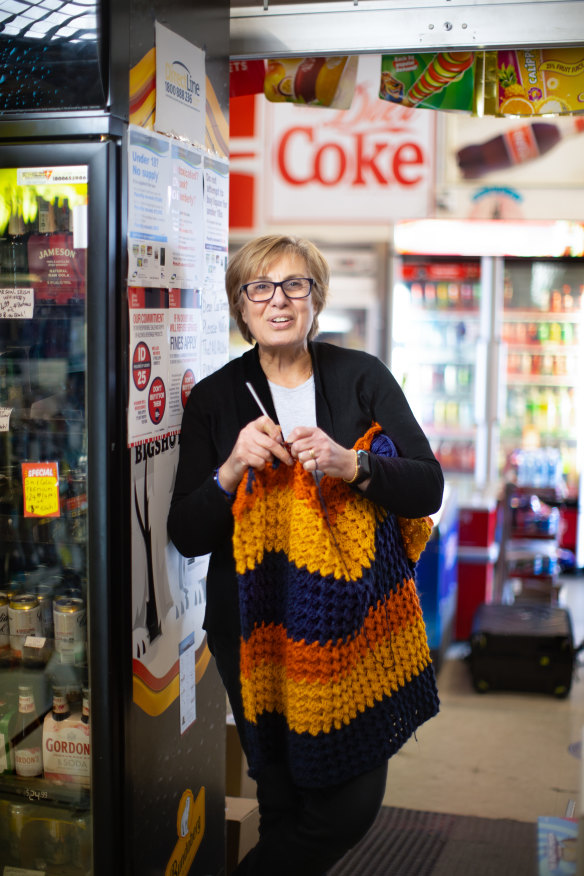
Shop owner and resident Tammy Zakharia has watched Moorabbin change since the 1990s.Credit: Simon Schluter
Back in 1998, when she moved to the suburb with her husband, the mother of four says the area was full of older people, including smatterings of European migrants.
Lebanese-born Zakharia says Moorabbin is now full of young families and professionals, and a new wave of Indian families, who have snapped up homes in the area after migrating from the subcontinent.
The influx of Indian families prompted the construction of the first Jain Derasar (temple) in Melbourne for the rising number of local worshippers of the ancient Indian religion.
Each Saturday, they pour into the temple on Rowans Road dressed in colourful traditional garments.
“It is like a festival every weekend,” Zakharia says.
Zakharia is pragmatic about the changes coming for the suburb, with tens of thousands of houses set to be built and high-density apartments forecast – including at Moorabbin Junction down the road.
“People have to live somewhere and this is one of the best places to live,” she says, listing off the suburb’s proximity to public transport; the city; health services, including The Alfred hospital; and the beach just a few kilometres to the west.
“Living in Moorabbin feels more like in the countryside, but it is so close to everything. We know everybody. I remember kids being born, and now they are coming into the shop as adults with their own babies. It is one big village.”
Behind the name
The name Moorabbin comes from the Indigenous term ‘Moorooboon’, believed to be of the Kulin language, which can be translated as mother’s milk or resting place.
The name Moorabbin is thought to pay homage to a special place where women and children rested and stayed together, while the men went hunting further afield.
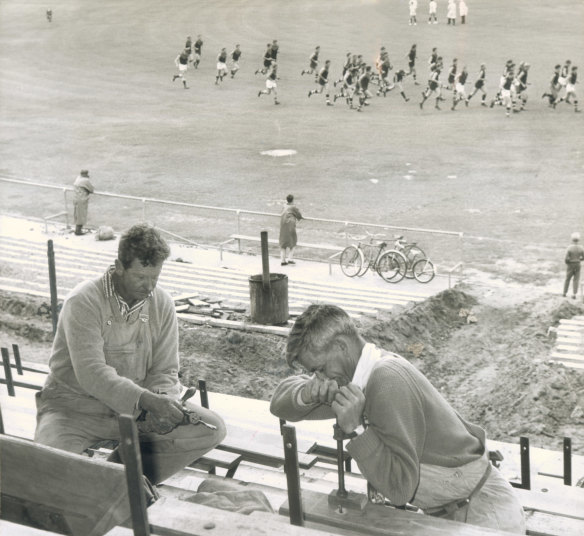
While the Saints went marching out to their practice match on their new ground at Moorabbin in 1965, workers were completing construction on the grandstand.Credit: The Age
After being colonised by European settlers John and Richard King in the 1840s, Moorabbin made its mark producing most of the fruit, vegetables and poultry in Melbourne.
An excerpt from an article in The Australasian dated August 25, 1906 describes the Moorabbin market gardens as picturesque and famed far and wide.
“To form an idea of the vast extent of country under fruit and vegetable cultivation it is only necessary to take the train to Cheltenham, about 13 miles distant,” the article reads.
“Here you will be landed in the midst of undulating, loamy country, dotted here and there with pretty little homesteads surrounded by orchards and crops that denote industry and prosperity, and which are a credit to their owners.”
From 1862 until the early 1990s, the City of Moorabbin was a local government area covering 53.13 square kilometres.
‘When I was a student at Melbourne Uni, all I wanted to do was move to the north and live in Brunswick. But now that vibe is finally coming to the southside.’
Kingston Mayor Jenna Davey-Burns
But in 1994 it was abolished and split three ways: Bentleigh was transferred into the newly created City of Glen Eira along with Caulfield; Brighton, Sandringham and parts of Cheltenham became part of the City of Bayside; and the City of Kingston was formed, taking in Moorabbin and several other suburbs, including Aspendale, Mentone, Mordialloc.
Carol Poole, the secretary of the City of Moorabbin Historical Society, has been tracing the history of the Kingston area for decades, and wishes more was known about the local Indigenous communities, who lived in the area for many years before colonisation.
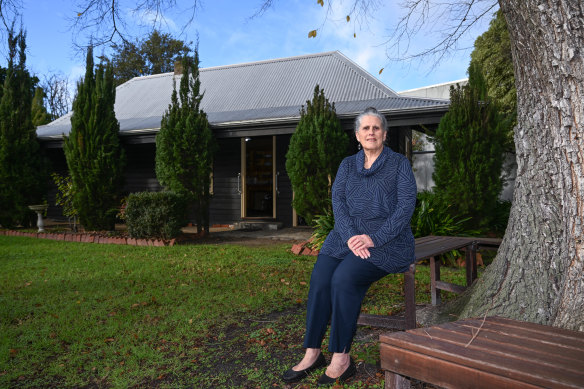
Carol Poole of the City of Moorabbin Historical Society has been tracing the history of the area for decades.Credit: Joe Armao
“It’s unfortunate because nothing was documented, and it should have been,” she says. “That’s the sad part … now we will never know what they could have taught us.”
The 78-year-old still remembers when families who lived in the suburb and surrounding areas such as McKinnon and Bentleigh used to drive less than 10 kilometres to their beach homes in Mordialloc.
Back then, in the 1950s and early ’60s, the land between Jasper and Tucker roads was full of swamps, farmland and paddocks.
“It was a bit like no man’s land,” she says. “It felt like you were out in the bush.”
For years, she and other historians in the area have collected and preserved items, from a Chinese silk wedding dress, to family photos, to newspaper clippings citing the first European settlers in the area. The collection is stored in the Box Cottage museum, a reconstruction of a dwelling thought to have been built in the mid-19th century, in the nearby suburb of Ormond.
For Poole, this collection has become especially precious as single post-war homes diminish.
“Now, there are about three houses on a block,” she says. “But these pieces of history show the first footprint which made Melbourne what it is today.”
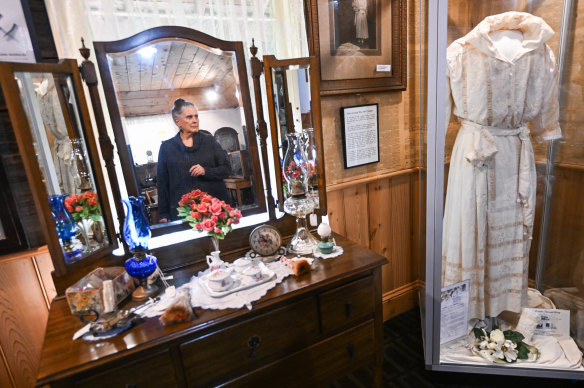
Poole at the Box Cottage museum, which has hundreds of historical items from the first European settlers in Melbourne.Credit: Joe Armao
Poole remains apprehensive about the projected explosion of houses and multi-storey apartment blocks in Kingston, fearing it could irreparably change the character of the area.
But Davey-Burns hopes the development will offer a diverse mix of homes to attract a new generation of young professionals, making it more affordable for families to move into Kingston.
“For me, it’s about how sustainable we’re creating the spaces that people are living in,” she says, naming more cycling paths and green, open spaces as crucial to Moorabbin’s future.
She also hopes others fall in love with Moorabbin like she has.
“When I was a student at Melbourne Uni all I wanted to do was move to the north and live in Brunswick,” she says.
“But now that vibe is finally coming to the southside. I don’t need to leave now because all the things that I want – which is good food, mixing of cultures, a pub to hang out, cool things to do, and interesting offerings – is all right here.”
Get the day’s breaking news, entertainment ideas and a long read to enjoy. Sign up to receive our Evening Edition newsletter here.